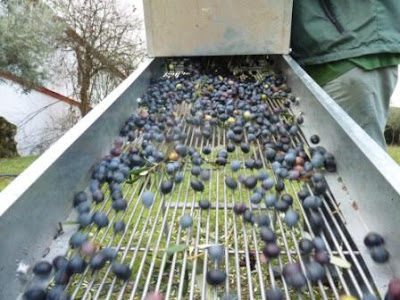Wonderful olives

If you walk along the narrow lanes or tracks in the small range of hills where we live at any time from late November through to January you will be bound to hear the "thwack - thwack" of the traditional olive harvest. Families will be out in their small olive groves, using long poles to hit the branches of the trees, so that the olives fall onto nets placed on the ground below the tree. Apparently the olives drop more easily once there have been a couple of hard frosts. In the large scale commercial olive plantations elsewhere, the harvest is mechanical, but on the small family holdings, often on quite steep slopes, harvesting is really only possible by hand. The purists do not even use poles, preferring to collect the olives in their fingers. That way there is less damage to the twigs (especially to the buds) and the olives suffer less bruising. But this can be very time-consuming when one is collecting the quantities needed for oil. A skilled harvester can however use the pole in a way that reduces damage - tapping, almost caressing the branches, so the olives fall by the vibration of the tapping rather than through brute force. We have a small olive grove too, and the annual harvest is a real highlight for us, a real social occasion (as indeed it is for many families here), with a picnic lunch and plenty of banter. There are also roving teams able to offer help and they work on the olive harvest right through the winter.
We use both the hand-picking and the pole methods, working a tree, collecting the olives that have fallen onto the net, taking them in a bucket to a sieve (see the attached photo taken by our son Patrick) to remove twigs and leaves and then pouring the fruit into sacks. This year, with the help of my sister and some local friends, we collected 14 sackfuls. These we took to an olive press where we receive the oil from our very own olives (there are also nearby cooperatives, where one can exchange olives for cash or oil). It is always exciting waiting to be told what the weight of the crop is (this year we harvested 457 kilos), then to watch the olives pass by conveyor belt to the press itself. Finally, a real sense of satisfaction to watch our own olive oil being poured into the five litre containers. We took home 69 litres of oil - enoughh for our annual consumption.
Some olives remain on the trees and there are plenty left on the ground. None are wasted. They represent a great energy source for birds in winter: Azure-winged Magpies (which store olives under leaves, like Jays store acorns), Hawfinches and winter visitors like Song Thrushes and Blackcaps. For the latter, oilves represent a key part of their winter diet and huge numbers spend the winter here from Central Europe. Indeed on gentle stroll along our lane for a couple of hours yesterday I saw or heard over 150 Blackcaps. Old olive trees with their gnarled trunks provide great foraging areas for Short-toed Treecreepers whilst every year a pair of Hoopoe nest in a cavity in one of our trees.



Comments